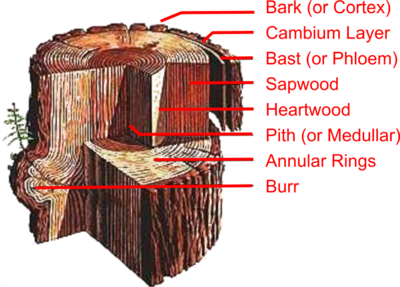Tree Structure: Difference between revisions
From DT Online
(Created Article) |
m (Added Category) |
||
| (3 intermediate revisions by the same user not shown) | |||
| Line 4: | Line 4: | ||
=====Introduction===== | =====Introduction===== | ||
As [https://en.wikipedia.org/wiki/Tree '''Trees'''] grow they put on an extra layers each year which thickens the trunk by the addition of '''Growth Rings'''. The rings are thicker in Spring and Summer than they are in Autumn and Winter, and thicker in a good season, because there is more growth. [https://en.wikipedia.org/wiki/Dendrology '''Dendrology'''] is the study of trees and [https://en.wikipedia.org/wiki/Dendrochronology '''Dendrochronology'''] makes use of the different patterns of '''Growth Rings''' to determine the age of timbers. | |||
The 'woody' trunks give the [https://en.wikipedia.org/wiki/Tree '''Tree'''] its strength. The more recent outer layers are made of living cells which conduct water and nutrients | |||
The 'woody' trunks give the [https://en.wikipedia.org/wiki/Tree '''Tree'''] its strength. The more recent outer layers are made of living cells which conduct water and nutrients throughout the tree. By comparison, the older, inner cells are dead. They harden and may become blocked or filled to make a dense central core which adds rigidity to the trunk. | |||
| Line 22: | Line 22: | ||
======Bark or Cortex====== | ======Bark or Cortex====== | ||
[https://en.wikipedia.org/wiki/Cortex_(botany) '''Bark'''] is the outer covering which provides some protection from extremes of temperature, frosts, fires, insects, fungi and | [https://en.wikipedia.org/wiki/Cortex_(botany) '''Bark'''] is the outer covering which provides some protection from extremes of temperature, frosts, fires, insects, fungi and animals. | ||
| Line 57: | Line 57: | ||
[[File:MedullaryRays.png|300px|right]] | [[File:MedullaryRays.png|300px|right]] | ||
=====Medullary Rays===== | =====Medullary Rays===== | ||
In addition to the concentric '''Annular Rings''', some trees ''(e.g. Oak)'', contain also cells radially. The cells build ribbon like structures running vertically up the tree from the centre outwards known as [https://en.wikipedia.org/wiki/Medullary_ray_(botany) '''Medullary Rays''']. Such trees when '''[[Timber Conversion|Quarter Sawn]]''' produce highly figured timber. | |||
[[Category:Materials and Components]] | |||
[[Category:Timber]] | |||
Latest revision as of 13:55, 4 January 2018
Introduction
As Trees grow they put on an extra layers each year which thickens the trunk by the addition of Growth Rings. The rings are thicker in Spring and Summer than they are in Autumn and Winter, and thicker in a good season, because there is more growth. Dendrology is the study of trees and Dendrochronology makes use of the different patterns of Growth Rings to determine the age of timbers.
The 'woody' trunks give the Tree its strength. The more recent outer layers are made of living cells which conduct water and nutrients throughout the tree. By comparison, the older, inner cells are dead. They harden and may become blocked or filled to make a dense central core which adds rigidity to the trunk.
Trees are either Evergreen which keep their leaves in winter or Deciduous which lose their leaves each year. Most Evergreen trees produce Softwood timbers and most Deciduous trees produce Hardwood.
Trunk Cross Section
The annual alternating light and dark Growth Rings become apparent when the trunk is sectioned. Also, the older, inner cells tend to be darker than the still living outermost cells.
Bark or Cortex
Bark is the outer covering which provides some protection from extremes of temperature, frosts, fires, insects, fungi and animals.
Cambium Layer
The still growing inner surface of the Bark is the Cambium Layer is the 'factory of the tree'. It is here where new cells are grown and added to the inside of the Bark and new 'woody' tissue (xylem) added around the inside layers to increase the girth of the tree.
Sapwood or Alburnum
All wood in a tree is first formed as Sapwood. This is the newly formed living part of the trunk which conducts water up to the branches and leaves.
Heartwood or Duramen (aka Truewood)
Over time, Sapwood cells become filled with deposits of substances such as gums, resins, and tannins. The cell walls thicken, harden and become cemented together with Lignin to form the fully developed and darker coloured Heartwood which supports and gives rigidity to the tree.
Pith or Medullar
As the tree grows, nutrients are drawn to the growing tips at the ends of twigs and branches along soft spongy tissue known as the Pith. Once wood cells form around it, this function ends and it becomes a cylinder of soft, usually dark brown, dead tissue extending throughout the length of the tree. It is most clearly seen in Softwood.
Annular Rings
Trees increase their girth by adding a Growth Ring, or Annular Rings - generally one each year. Cells formed early in the growing period (i.e. Spring), when growth is rapid, tend to be wide a thin walled. The wood produced is usually softer, lighter in colour and in weight than 'later wood'. Cells formed in late Summer and Autumn are narrow, thick-walled and the wood is more dense, harder and often darker than 'early wood'.
Burr
Burrs are the wart-like growths which sometimes form to cover wounds on the trunks of many trees. Their grain is highly figured and therefore much sought after for use as decorative Veneer
Medullary Rays
In addition to the concentric Annular Rings, some trees (e.g. Oak), contain also cells radially. The cells build ribbon like structures running vertically up the tree from the centre outwards known as Medullary Rays. Such trees when Quarter Sawn produce highly figured timber.


